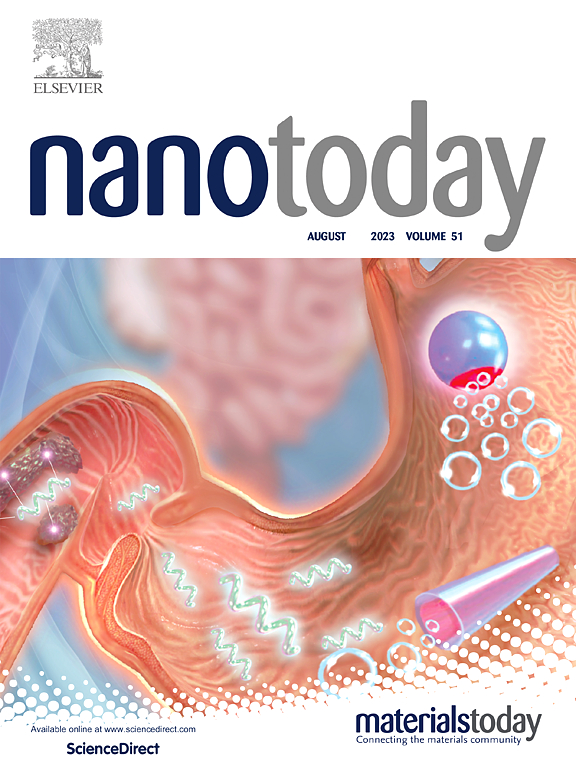利用氢溢出:模拟NAD+还原氢化酶的仿生双位点铂金催化剂
IF 13.2
1区 材料科学
Q1 CHEMISTRY, MULTIDISCIPLINARY
引用次数: 0
摘要
多相催化中的氢溢出现象与天然酶中的质子耦合电子转移(PCET)机制有相似之处。从这些机制中获得灵感,仿生双位点铂金(PtAu)催化剂被设计为模拟可溶性NAD+还原氢化酶(SH)功能的模型。该模型催化剂促进了高效的氢氧化和NAD+还原,在生物电催化和生物合成系统中都有潜在的应用。在设计中,Pt和Au分别模拟了SH的NiFe和FMN活性位点,氢气溢出作为PCET机制的替代机制。实验结果和理论计算揭示了Pt和Au之间的个体贡献和协同作用,其中Pt位点解离H2产生活性氢,并自发地溢出到邻近的Au位点吸附NAD+氢化。在生物催化方面,与先前报道的基于pt的催化剂相比,PtAu催化剂对1,4- nadh的转化效率和选择性更高。在电催化方面,构建了H2/O2酶生物燃料电池,最大输出功率超过2.0 mW cm−2,同时保持了良好的运行稳定性。这种机制启发的策略为催化剂的理解和设计提供了有价值的见解,从而为取代天然酶催化的应用提供了更大的潜力。本文章由计算机程序翻译,如有差异,请以英文原文为准。
Harnessing hydrogen spillover: Biomimetic dual-site platinum-gold catalyst mimicking NAD+ -reducing hydrogenase
The hydrogen spillover phenomenon in heterogeneous catalysis shares similarities with the proton-coupled electron transfer (PCET) mechanism observed in natural enzymes. Drawing inspiration from these mechanisms, biomimetic dual-site platinum-gold (PtAu) catalyst was theoretical designed as a model to mimic the function of soluble NAD+-reducing hydrogenases (SH). This model catalyst facilitates efficient hydrogen oxidation and NAD+ reduction, offering potential applications in both bioelectrocatalysis and biosynthetic systems. In the design, Pt and Au simulated the NiFe and FMN active sites of SH, respectively, with hydrogen spillover serving as an alternative to the PCET mechanism. Experimental results and theoretical calculations revealed the individual contribution and synergistic interactions between Pt and Au, where Pt sites dissociated H2 to produce active hydrogen which spontaneously spilled to neighboring Au sites for adsorbed NAD+ hydrogenation. In biocatalysis, PtAu catalyst exhibited superior NAD+ conversion efficiency and selectivity toward 1,4-NADH compared to previously reported Pt-based catalysts. In electrocatalysis, a H2/O2 enzymatic biofuel cell was constructed, achieving a maximum power output exceeding 2.0 mW cm−2 while maintaining excellent operational stability. This mechanism-inspired strategy provided valuable insights into the understanding and design of catalysts, thereby offering greater potential for applications in replacing natural enzymatic catalysis.
求助全文
通过发布文献求助,成功后即可免费获取论文全文。
去求助
来源期刊

Nano Today
工程技术-材料科学:综合
CiteScore
21.50
自引率
3.40%
发文量
305
审稿时长
40 days
期刊介绍:
Nano Today is a journal dedicated to publishing influential and innovative work in the field of nanoscience and technology. It covers a wide range of subject areas including biomaterials, materials chemistry, materials science, chemistry, bioengineering, biochemistry, genetics and molecular biology, engineering, and nanotechnology. The journal considers articles that inform readers about the latest research, breakthroughs, and topical issues in these fields. It provides comprehensive coverage through a mixture of peer-reviewed articles, research news, and information on key developments. Nano Today is abstracted and indexed in Science Citation Index, Ei Compendex, Embase, Scopus, and INSPEC.
 求助内容:
求助内容: 应助结果提醒方式:
应助结果提醒方式:


